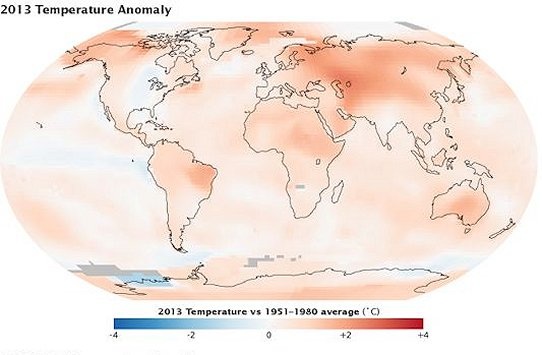
NASA: climate warming continued in 2013

Scientists at the US National Aeronautics and Space Administration (NASA) say last year tied with 2006 and 2009 for the seventh warmest since 1880, “continuing a long-term trend of rising global temperatures”.
Except 1998, the 10 warmest years after 1880 have all occurred since 2000, with 2005 and 2010 ranking as the warmest on record, the scientists said.
NASA’s Goddard Institute for Space Studies (GISS) in New York, which analyzes global surface temperatures, said on Tuesday the Earth “continues to experience temperatures warmer than those measured several decades ago,” according to a report on NASA’s science news website.
“Long-term trends in surface temperatures are unusual and 2013 adds to the evidence for ongoing climate change,” said GISS climatologist Gavin Schmidt.
“While one year or one season can be affected by random weather events, this analysis shows the necessity for continued, long-term monitoring.”
Human influence
The average temperature in 2013 was 14.6 degrees Celsius (58.3 degrees Fahrenheit), which is 0.6C (1.1F) warmer than a 1951–80 baseline average.
The average global temperature has risen 0.8C (1.4F) since 1880, according to the new GISS analysis.
Last September, the IPCC’s Working Group I report, on the science behind climate change, reported that it is “extremely likely” that human influence – mainly fossil fuels – has been the dominant cause of the observed increase in global temperature since the mid-20th century.
The NASA scientists emphasize that weather patterns cause fluctuations in average temperatures from year to year, but “continued increases in greenhouse gas levels in Earth’s atmosphere are driving a long-term rise in global temperatures”.
Agreement
The US experienced its 42nd warmest year on record last year, according to the GISS data, but other countries such as Australia saw their hottest year on record in 2013.
The GISS data is compiled from more than 1,000 meteorological stations around the world, Antarctic research station measurements and satellites, with the period 1951 to 1980 providing a baseline average (see picture).
The scientists say it has been nearly four decades since they recorded a year that was cooler than average.
The global temperature analyses by the US National Oceanic and Atmospheric Administration and the UK Met Office Hadley Centre use slightly different methods but overall show close agreement with GISS.
The NASA chart shows 2013 colour-coded temperature anomalies – departures from the 1951–80 baseline average. (Picture: NASA Earth Observatory)